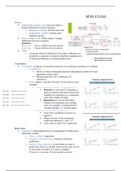Samenvatting
Summary Everything you need to know for the SPSS exam from ARMS
It contains everything you need to know about SPSS for the ARMS exam. How to perform certain analyzes and how the output should be interpreted. In short: everything you need to pass the SPSS exam
[Meer zien]




